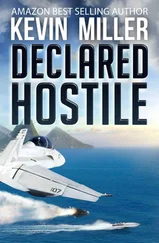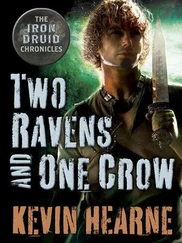“Thank you, sir,” Wilson replied.
Cajun turned to depart and over his shoulder said, “All Officers Meeting, followed by APM tomorrow.”
“Yes, sir.”
When he reached the ready room door, he turned again and added, “Put me with Sponge on the next event, preferably a 1v1 with him leading.” Cajun winked with the trace of a smile.
“Aye, aye, Skipper,” Wilson said, relieved that Cajun was back aboard.
Wilson stepped out onto the well of the catwalk ladder and looked down through the grating. Some 50 feet below, the ship made huge waves as it pushed through the Gulf of Oman. He climbed up a few steps to the starboard catwalk to assess the weather: clear, sunny, warm, gentle wind. Considering the speed the ship was making, Wilson was surprised by the wind and figured it around 20 knots… and out of the south since the ship was headed north by west. He walked aft and found the small ladder that led to the flight deck. He kept his head down, climbed the steps and crouched low in order to step over the deck edge coaming and onto the deck. Still ducking, he moved under a Hornet horizontal stabilator and moved along the aircraft, avoiding obstacles such as tie-downs, trailing edge flaps, and the external fuel tanks hanging on the wings. The engine turbine blades turned freely in the breeze. Their steady chatter created the ever-present wind chime of the flight deck.
He had eaten lunch only a short time ago, but this was the first time he had been outside that day. Across the deck he saw a squadron maintenance crew working on an aircraft; to his left a plane captain stood in a Hornet cockpit as he polished the windscreen. Dozens of joggers ran up and down the 1,000-foot flight deck as they followed a deformed racetrack pattern that avoided parked aircraft and yellow flight deck tractors. He spied Smoke and Lieutenant “Blade” Cutter, the squadron strike fighter tactics instructor, moving in long strides — down the deck and with the wind. A leisurely no-fly day on the flight deck.
He walked aft behind a Raven jet; his trained eye scanned its skin for signs of corrosion. When he found an area between two aircraft where he could stand with an unobstructed view of the horizon, he looked across the Strait of Hormuz. Miles to starboard — Wilson estimated over 20 miles — he saw the shadow of a ridgeline. Just visible in the distance. Iran.
Each time he had been to the Gulf, Wilson was struck by the desolate and forbidding landscape. To him, the entire Arabian Peninsula was simply inhospitable. Centuries of crushing heat and simoon winds had baked and eroded the land into one of the most continuous bodies of sand in the world. When he looked at the charts in the ready room, Wilson noted one could go hundreds and hundreds of miles and see nothing but sand dunes. Called The Empty Quarter, this inland sea of sand was so barren that the borders of Saudi Arabia, United Arab Emirates, and Oman were not distinguishable. From Aden all the way up to Baghdad, the terrain, and everything on it, was a light shade of sand marked with occasional patches of tan. Even the towns were tan; the only things not tan or sand were the black asphalt roads and the blue gulf along the coast. Flying over Arabia was like flying over a giant horizon-to-horizon sandbox , which is what three generations of American military personnel called the U.S. Central Command Area of Responsibility.
As he surveyed Iran in the distance, Wilson reflected on the times he was high over the Persian Gulf at night. To the south and west, the countries of the Gulf Cooperation Council were illuminated with bright clusters of lights in the cities and settlements. Natural gas flare stacks flickered and burned off at the well heads at oil fields ashore and on platforms dotting the Gulf. Desert roads in the middle of nowhere were lighted as if the roads were in a large city. Far to the south the modern metropolises of Dubai and Abu Dhabi shone brightly, and further up the Gulf, the cities of Doha, Manama, Dhahran and Kuwait City glowed — evidence not only of life but of prosperity. In this part of the world, light meant money, and under the sandy desert of the Arabian Peninsula, the former nomadic peoples of the region sat on a pile of it.
To the east and north it was another matter. Aided by the fact that the Iranian coastline was mountainous, and to a great extent devoid of humans for some 400 miles — from Bandar Abbas to the Bushier/Kharg Island complex — Iran gave the impression of being dark and foreboding. Even well inland, there were few lights to signify settlements. Basra in Iraq seemed to have a greater degree of lighting than a comparable Iranian town. Wilson found the Iraq/Iran comparison a perplexing metaphor — free enterprise on one side and essentially a command economy on the other, with both dominated by a religion that oversaw every aspect of its believers’ lives. Despite their similarities, the two peoples regarded each other with deep suspicion, and in the case of the sheikdoms, fear of their powerful and populous Shiite neighbor to the north. They disagreed about much, even the name of the body of water that separated them. Persian Gulf. Arabian Gulf. To be fair, it could not be said that the GCC sheikdoms were free , but when he could actually view the paradox in the light patterns he saw whenever he flew high over the Gulf at night, he found it fascinating.
All around Valley Forge merchant ships plied the strait, visual proof that 30 % of the world’s crude oil passed through this vital strategic waterway. Behind the ship, and all the way to the horizon, a line of black-hulled oil tankers rode high in the water as the Indian Ocean funneled them into the Gulf to pick up loads of crude from Dhahran or Kharg Island-or maybe from Iraq. Far to the south, he could make out the white superstructure of a very large crude carrier, its hull obscured by the horizon.
One mile to port, a full tanker rode low in the water and pushed the sea before it as it lumbered into the open ocean with another 100,000-ton load of crude. Wilson scanned the deck and peered into the bridge — no sign of human life. In all his years of observing merchant ships on the high seas, even when he flew right over them, he never saw sailors on deck. For a moment Wilson wondered where the tanker was headed, and thought of Norfolk. He then noted the flag flying from the mast; it appeared to be Japanese.
Further to port, the mountainous and seemingly deserted coastline of Oman was visible, a landscape dominated by dull sandy browns and grays, with a touch of olive drab vegetation, but mostly a light beige color, or coffee with cream, which was the primary shade of the whole Arabian Peninsula. Wilson walked further up the angled deck to get a better view. Merchant ships dotted the horizon; Valley Forge was passing a blue-hulled containership that had shipping containers stacked high over all available deck space to bridge level. The officers on the carrier’s bridge had much to contend with while avoiding traffic in these restricted waters. Their efforts were compounded by dozens of speedboats crisscrossing the narrowest part of the strait between Iran and Oman. Smugglers .
Wilson got to the end of the angled deck and stood there to watch the speedboats bound north and south over the waves. They left thin, white wakes as they weaved between the large merchants heading either east or west in this portion of the strait. Carpets, gold, knock-off clothing, watches, CD’s, and who knows what else stashed in those fiberglass hulls… He surmised some of the boats were boghammars , the ubiquitous Iranian Revolutionary Guard speedboats with small arms and RPGs used to harass shipping. Modern day pirates following centuries of tradition in this God-forsaken place. The vessels change shape, but the business stays the same , he thought.
Читать дальше












